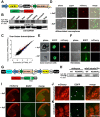Heritable expansion of the genetic code in mouse and zebrafish
- PMID: 27934867
- PMCID: PMC5339847
- DOI: 10.1038/cr.2016.145
Heritable expansion of the genetic code in mouse and zebrafish
Figures

References
Publication types
MeSH terms
Grants and funding
LinkOut - more resources
Full Text Sources
Other Literature Sources
Molecular Biology Databases

